#laws of logarithms
Text
youtube
#relations and functions#domain of a function#class 11 maths relations and functions#functions and relations class 11#domain and range of a function#relation function class 11#relation and function class 11#class 11 relation and function#logarithms#properties of logarithms#logarithmic functions#logarithms explained#evaluate logarithms#solving logarithmic equations#laws of logarithms#natural logarithms#logarithms rules#logarithms review#logarithms tutorial#Youtube
0 notes
Text
TEACHING AND LEARNING LAWS OF LOGARITHMS: A PROSPECTIVE PEDAGOGY | Journal of Global Research in Education and Social Science
According to the literature, pupils have a rudimentary comprehension of the laws of logarithms, including misunderstandings. Despite the fact that these rules are critical in learning advanced mathematics, this is the case. The difficulty in acquiring these concepts is largely related with rule-based teaching, which fosters rote learning and is not supported by learning psychology, according to this research, which is based on teaching experience, textbook analysis, and classroom observation. A guided inquiry oriented, ICT enhanced, investigative pedagogy is presented to address challenges with product, quotient, and power norms. Students will work in small groups to analyse both accepted and unanticipated (misconceptions) log rule equations side by side. They create their own data by plotting 3D graphs of the above equations and solving them. They are then advised to examine similarities and differences in the ranges of the equations data to pick the most acceptable and general log rule equations by testing their self-generated and teacher-provided data. This method is assessed using learning theories, and it is backed up by constructivism and neurocognition. This approach is recommended for future investigation into smart teaching and learning, given the stated benefits for teaching laws of logarithms.
Please see the link :- https://www.ikprress.org/index.php/JOGRESS/article/view/1800
0 notes
Text

55 notes
·
View notes
Text
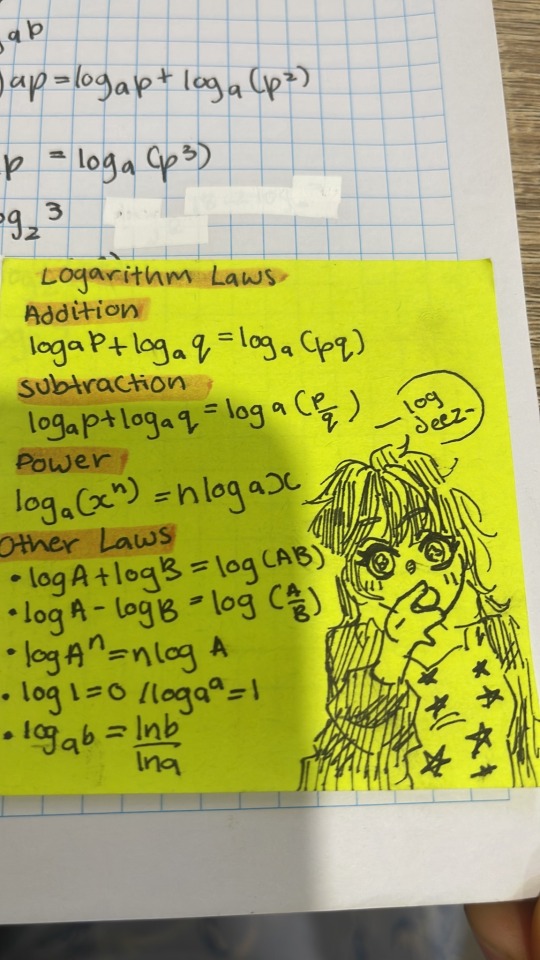
why cant the log find its own rhythm bro 😭😭
#art#sketchbook#maths#mathshw#logarithm#logarithms#log laws#what#i made a mistake#i accidentally picked advanced maths for next year#like im doing 5.3 rn which is alr advanced#and like ive pretty much finished most of standard content so advanced shouldnt be THAT bad#but like#still#why did i do that#im good at maths#i hate it#a lot
2 notes
·
View notes
Text





















Наутилус (лат. Nautilus) — род головоногих моллюсков, которых относят к «живым ископаемым». Самый распространенный вид — Nautilus pompilius. Наутилусы относятся к единственному современному роду подкласса наутилоидей. Первые представители наутилоидей появились в кембрии, а его развитие пришлось на палеозой. Наутилиды почти вымерли на границе триаса и юры, но все же дожили до наших дней, в отличие от своих родственников аммонитов. Некоторые виды древних наутилусов достигали размера в 3,5 м. Представители самого крупного вида современных наутилусов достигают максимального размера в 25 см.
Спиральный «домик» моллюска состоит из 38 камер и «построен» по сложному математическому принципу (закон логарифмической прогрессии). Все камеры, кроме последней и самой большой, где размещается тело наутилуса с девятью десятками «ног», соединяются через отверстия между собой сифоном. Раковина наутилуса двухслойная: верхний (наружный) слой – фарфоровидный – действительно напоминает хрупкий фарфор, а внутренний, с перламутровым блеском – перламутровый. «Домик» наутилуса растет вместе с хозяином, который перемещается по мере роста раковины в камеру попросторней. Пустое жилище моллюска после его гибели можно встретить далеко от его места обитания – после гибели «хозяина» их раковины остаются на плаву и перемещаются по воле волн, ветров и течений.
Интересно, что двигается наутилус «в слепую», задом наперед, не видя и не представляя препятствий, которые могут оказаться на его пути.И еще одно удивительное качество этих древних обитателей Земли – у них потрясающая регенерация: буквально через несколько часов раны на их телах затягиваются, а в случае потери щупальца быстро отрастает новое.
Nautilus is a genus of cephalopods, which are classified as "living fossils". The most common species is Nautilus pompilius. Nautilus belong to the only modern genus of the Nautiloid subclass. The first representatives of the Nautiloids appeared in the Cambrian, and its development took place during the Paleozoic. The Nautilids almost died out on the border of the Triassic and Jurassic, but still survived to the present day, unlike their Ammonite relatives. Some species of ancient Nautilus reached a size of 3.5 m. Representatives of the largest species of modern nautilus reach a maximum size of 25 cm.
The spiral "house" of the mollusk consists of 38 chambers and is "built" according to a complex mathematical principle (the law of logarithmic progression). All chambers, except the last and largest, where the nautilus body with nine dozen "legs" is located, are connected through holes with a siphon. The nautilus shell is two–layered: the upper (outer) layer – porcelain–like - really resembles fragile porcelain, and the inner, with a mother-of-pearl luster - mother-of-pearl. The nautilus's "house" grows with its owner, who moves as the shell grows into a larger chamber. The empty dwelling of a mollusk after its death can be found far from its habitat – after the death of the "owner", their shells remain afloat and move at the will of waves, winds and currents.
Interestingly, the Nautilus moves "blindly", backwards, without seeing or imagining the obstacles that may be in its path.And another amazing quality of these ancient inhabitants of the Earth is that they have amazing regeneration: in just a few hours, the wounds on their bodies heal, and in case of loss of tentacles, a new one grows quickly.
Источник:://t.me/+t0G9OYaBjn9kNTBi, /sevaquarium.ru/nautilus/, /habr.com/ru/articles/369547/, //wallpapers.com/nautilus, poknok.art/6613-nautilus-molljusk.html, //wildfauna.ru/nautilus-pompilius, /www.artfile.ru/i.php?i=536090.
#fauna#video#animal video#marine life#marine biology#nature#aquatic animals#cephalopods#Nautilus#nautilus pompilius#living fossils#ocean#benthic#coral#plankton#beautiful#animal photography#nature aesthetic#видео#фауна#природнаякрасота#природа#океан#бентосные#головоногие моллюски#Наутилус#живое ископаемое#коралл#планктон
148 notes
·
View notes
Photo
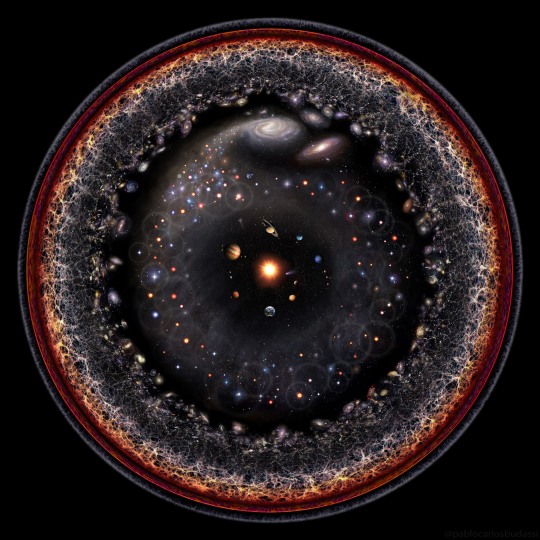
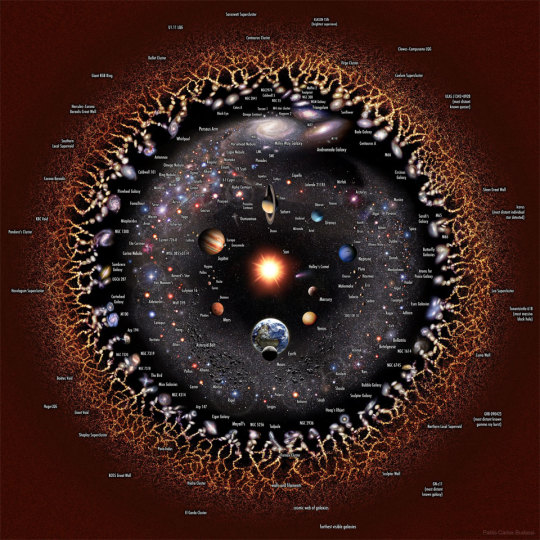
The Eye of the Universe. Pablo Carlos Budassi
How far can you see? Everything you can see, and everything you could possibly see, right now, assuming your eyes could detect all types of radiations around you -- is the observable universe. In light, the farthest we can see comes from the cosmic microwave background, a time 13.8 billion years ago when the universe was opaque like thick fog. Some neutrinos and gravitational waves that surround us come from even farther out, but humanity does not yet have the technology to detect them. The featured image illustrates the observable universe on an increasingly compact scale, with the Earth and Sun at the center surrounded by our Solar System, nearby stars, nearby galaxies, distant galaxies, filaments of early matter, and the cosmic microwave background. Cosmologists typically assume that our observable universe is just the nearby part of a greater entity known as "the universe" where the same physics applies. However, there are several lines of popular but speculative reasoning that assert that even our universe is part of a greater multiverse where either different physical constants occur, different physical laws apply, higher dimensions operate, or slightly different-by-chance versions of our standard universe exist.Extended universe logarithmic illustration
172 notes
·
View notes
Text
Physics Friday #14: Sound (Part 2/2)
Preamble: Let's get straight into it
Education Level: Primary School (Y5/6)
Topic: Sonic Physics (Mechanics)
The previous part 1 of my sound post is here.
Pitch and Frequency
Pitch and frequency are related to eachother, the only difference being that frequency is a physical interpretation of sound and pitch is our own mental interpretation of it.
But what exactly is frequency?
Go back to last time's example of a tick sound occurring at regular intervals ... because this sound is repeating, we can describe it's behaviour by measuring mathematical properites:
How much time passes in-between each tick (Period)
How many ticks occur every second (Frequency)
These two ideas are related to eachother, in fact Frequency is 1/Period. If you have a tick every half-second, then you can say the tick occurs twice every second.
We measure sound in Hertz, which is effectively a measure of ticks per second.
Most sounds, however, don't work this way, with repeated ticks. They act as proper waves. With zones of high pressure (peaks), and low pressure (troughs). This is where we have to introduce another variable into our equation:
The physical difference separating each peak (Wavelength)
Since these waves travel forward in the air, a detector (like our ears) will pick up the peaks and troughs as they reach our ear. We can measure frequency or period by recording the speed at which our peaks reach our ear.
But we also can relate frequency to wavelength. After all, the further apart the waves are separated, the more time it'll take for a peak to reach us after the previous one.
We quantify this relationship using c = fλ. Where c is the speed of the wave, f is the frequency, and λ is the wavelength.
Notice that we can also say cT = λ, where T is the period. This demonstrates that the physical wavelength is proportional to the amount of time between each peak.
So where does pitch come in?
As mentioned in part 1, if we continue to decrease the time between each tick, or increase the frequency, at some point we'll begin to hear a sound.
This is our brain playing a trick on us. It's like frames-per-second but for our ears. Below some fps threshold, we can see the individual pictures of a video, but above the threshold, it looks like a continuous film. Notice that fps is also another form of frequency.
When we reach this level, our brain can't distinguish between each tick and sees it as one sound. We begin to hear our first sound.
At this point, frequency becomes tied to pitch. The more rapid the ticking becomes, the higher of a pitch we hear. This is a choice that our brain makes - it's purely psychological.
Mixing different pitches
Combining different pitches allows us to create a foundation for music. In western music, our source of harmonics comes from Pythagoras, who kinda fucked it up by not using irrational numbers.
An octave is defined as a higher sound that has twice the frequency of the lower sound i.e. a ratio of 2:1. One octave above middle C (at about 262 Hz) gives us C5 (at about 524 Hz).
We can create further subdivisions like a perfect fifth, where frequencies form a 3:2 ratio. Or a perfect fourth, which has a ratio of 4:3.
Volume, Intensity, and the Inverse Square Law
Volume is directly related to the amplitude of a sound wave. Effectively, how strongly is the air being compressed at each peak?
Again, volume is just another psychological interpretation of a physical phenomena. Similar to how our eyes see brightness.
Amplitude isn't just interpreted as volume, it is also the power that the sound waves carry. Smaller amplitudes correspond to less energy contained within the moving particles.
We measure intensity logarithmically, because that's what our ears here. Effectively a wave sounds twice as loud only if the wave is 100 times as amplified. It's a similar effect to pitch, where we multiply frequencies instead of adding them.
That's where the decibel scale comes in. 1 dB = a 10x increase in the sound's power output. The decibel scale is used generally for a lot of measurements of wave/power intensity. However it just so happens that our ears behave in very similar ways.
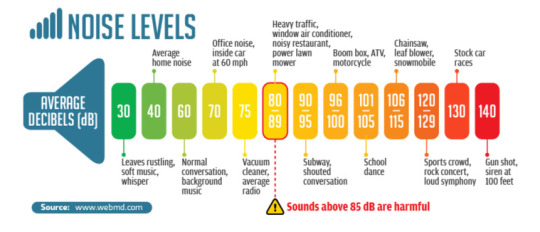
Image credit: soundear.com
Notice that louder sounds are more likely to damage our ear. That's because when loud sounds reach our ear, it causes the inner components to vibrate. This vibration amplitude generally is proportional to the amplitude of the waves.
Too loud of a sound means that our eardrums are vibrating with too great of a physical movement. This can create tears in tissue that damage our ears' sensitivity to sound.
Sound looses power over distance
If you stand far away enough from a sound source, it sounds fainter, eventually becoming unhearable.
This is because of the inverse square law. As sound spreads out over distance, it has to emanate in the form of a sphere, going outward in every direction, in order to maintain consistency of direction.
The same amount of power gets spread thinner and thinner over the bubble that it creates. The surface area of a sphere increases to the square of it's radius.

Image Credit: Wikipedia
Thus we get a decrease in volume over time.
What the Actual Fuck is Timbre, and how do you pronounce it? (also Texture too)
Unfortunately I still don't know how to pronounce it.
Timbre is defined as the quality and the colour of the sound we hear. It also includes the texture of the sound. It's sort of the catch-all for every other phenomena of sound.
Timbre is a bit more complex of a phenomena. In that, it combines basically everything else we know about how we hear sound. So I'll go one by one and explain each component of what makes Timbre Timbre.
Interference
Wave interference is an important property that needs to be understood before we actually talk about timbre. Sound waves often can overlap eachother in physical space, normally caused by multiple sound sources being produced at different locations.
These sound sources often will create new shapes in their waveform, via interference.
Constructive interference is when the high-pressure zones of two sound waves combine to produce an even-higher-pressure zone of wave. Effectively pressure gradient add onto eachother.
Destructive interference is when a high-pressure zone overlaps with a low-pressure zone, causing the pressure to average out to baseline, or something close to the baseline.

Image Credit: Arbor Scientific (Youtube)
We can look at multiple waves acting continuously over a medium to see how their amplitudes will add up together using interference. This is the origin of more unique wave patterns.
The shape of a wave
Sound waves can come in different varieties. While the most basic shape is the sine wave. We can add different intensities, frequencies and phases of sine waves to produce more complex patterns.
I won't go into how this combination works because that's better left for a Fourier series topic. Just know that pretty much any sound can be broken down into a series of sine waves.
These patterns have a different texture, as they combine multiple different monotone sounds. Take a listen to a sawtooth wave vs a sine wave:
Warning: the sawtooth wave will sound a lot louder than the sine wave.
This gives us a different sound texture.
Resonance
When you play a musical instrument at a particular frequency, the instrument is often resonating.
Say you produce sound within an enclosed box. Producing it at one end. Eventually the sound will reach the end of the box and bounce back from reflection (as we'll see later).
The sound will bounce back and forth, combining itself with the previous waves to produce more and more complex waveforms.
But there is a particular frequency, at which, the waves will perfectly interfere with eachother to produce what's known as a standing wave.
A standing wave will oscillate, but it will appear as if it's not moving forward. Of course, power is still moving throughout the wave, as we'll still be able to hear something.
This standing wave can only occur at a particular frequency, one in which the wave perfectly interferes with it's reflection within the box.
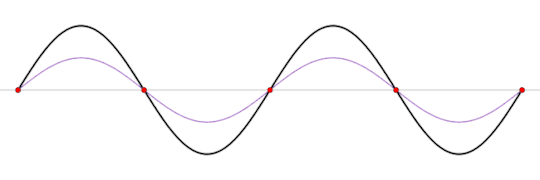
A standing wave (black) that is produced by two sine waves (blue and red) moving in opposite directions
Image source: Wikipedia
This frequency is called the resonant frequency of the box. This frequency depends on several factors like the speed of the wave, the material inside the box, the shape of the box, and the length of the box.
The resonant frequency can be activated by our voices, as our voices or just blowing air is already a combination of different sound frequencies. The non-resonant frequencies will eventually loose all of their power as they destructively interfere, leaving only the resonant frequency, which gets amplified by what we put in
For example, you can fill a glass bottle halfway with some water, blow in it, and it will produce a particular sound. Fill it with more water, and the pitch increases - i.e. by adding the water we increase the resonant frequency.
All instruments have one or more resonant frequencies based on their material and shape (I say multiple because some instruments can me modelled as multiple boxes. Like a violin will have the inside of the wood, the wood itself, the strings, etc.).
Instruments also allow us to alter the resonant frequency by playing it differently (like putting a finger over your recorder's hole (phrasing)).
These differences in how we obtain resonance can also affect the quality of the sound.
Overtones
Resonance is not just generated with a single resonant frequency, we can create resonance with higher multiples of the the same fundamental frequency.
This is because in our box model, multiplying the fundamental frequency will allow us to create a standing wave, just with a shorter wavelength:

The A's stand for antinodes, which vibrate in the standing wave with the maximum amplitude. The N's stand for nodes, which do not move at all.
Image Credit: Macquarie University
Direct multiples of the fundamental frequency are called harmonics. Instruments can also produce other frequencies not directly harmonic depending on the structure of the 'box' they utilise.
These additional frequencies, ones which come often in fractional multiples of the fundamental are called partials. Both partials and harmonics represent the overtones of an instrument.
Overtones are what give sound additional character, as they allow instruments to not just resonate at the note they play, but at other combined frequencies. In some instruments, the overtones dominate over the fundamental - creating instruments that can play at much higher pitches.
Envelopes and Beats
Say we add two sine waves together (red and blue), each with slightly different frequencies, what we get is this:

Image Credit: HyperPhysics Concepts
We can see that the brown wave has a singular oscillation frequency, but also it's amplitude continuously scales with reference to this hidden envelope frequency, called the beat frequency (dotted line).
This difference between the actual wave's real frequency and the wave's overall frequency envelope. Is another source of timbre.
Notes, and the way we play them will often generate unique and different envelopes depending on how they are played. For example a staccato quarter-note will have a different envelope to a softly played quarter-note.
Other properties of Sound
Reflection
Different mediums mean different speeds of sounds e.g. molecules in wood (solid) are harder to move than molecules in air (gas).
These different speeds create several effects. Including the reflection of waves. Often waves require a bit of power in order to physically overcome the resistances to vibration of a particular medium.
Often this leads to sound waves bouncing back off harder-to-traverse surfaces.
Say that a sound wave travels through the air and reaches a wooden wall. The atoms vibrating in the air will hit against the wooden wall, transferring only some of their energy to the resistant wood.
The wood atoms on the border of the wall will bounce back, as expected. But this time they will transfer energy back into the air at a much greater magnitude due to newton's third law.
Thus while some of the sound wave ends up going deeper into the wood, the wood will push back and cause the air to vibrate in the opposite direction, creating a reflected wave.

Image credit: Penn State
We characterise the amount of power being reflected versus transmitted versus absorbed using portions:
A + R + T = 1
A = Power absorbed into the material (e.g. warms up the material)
R = Power reflected back
T = Power transmitted into the new medium
This is both an explainer as to why rooms are both very good, and very bad at keeping sound inside them. It really depends on the rigidity and shape of the material they are bordered by.
Refraction
Just like light, sound waves can also refract. Refraction is actually a lot simpler to understand once you already realise that waves will both reflect and transmit across medium changes.
Refraction is just combining the results of incomplete reflection (i.e. transmission) with some angle.
I won't go into refraction in too much detail, as it's worth a different topic. But effectively we experience snell's law but modified for sound.
Diffraction
Sound waves, like all waves propagate spherically (or circularly in 2D).
When travelling around corners, sound can often appear louder than if you were further away, looking at the source more directly.
This is because spherical waves will often 'curve' around corners. This is better described by light diffraction. Which is something for another time.
Conclusion
In conclusion, that's how sound works, mostly. This is a topic that is a little less closer to my expertise. Mainly because it delves into more musically-inclined phenomena that I am less familiar with. But I'm sure I did a good job.
Unfortunately, it seems like the plague of the long post is not yet over. Perhaps I need to get into a lot more specific topics to make things better for me and you (the reader).
Anyways, my exams are done. I am done. I do not have to do school anymore. Until I remember to have to get ready for my honours year (a.k.a. a mini-masters degree tacked on after your bachelor's degree).
Until next time, feel free to gib feedback. It's always appreciated. Follow if you wanna see this stuff weekly.
Cya next week where I will probably try another astronomy topic, or something like that.
63 notes
·
View notes
Note
Hi! Do you have any tips for studying chemistry? For some reason I cant seem to get all the formulas in my brain.
Hey!
My unhelpful but still favorite advice for shoving formulas into one's brain is to understand them 😅 A purely memorization-based approach is very bad for chemistry.
If the problem seems to be particularly understanding/ remembering formulas:
Ask yourself if this particular formula is just words turned into numbers and mathematical symbols. I think it may not work for everyone, but for example I found it easier to remember the literal definition of pH that is "the negative decimal logarithm of hydrogen ion concentration" rather than "pH = -log [H+]" bc otherwise I'd keep forgetting about the minus sign.
Check if you find deriving a formula from another formula easier than just memorizing it. Again, my personal example is I hate memorizing things so much I never really bothered to remember the equation that describes Ostwald's law of dilution - bc I knew I could easily, quickly, and painlessly derive it from the equilibrium constant for concentration + degree of dissociation (and I've done it so many times now it stuck in my brain anyway).
When all else fails, I turn to mnemotechnics. To this day I remember that Clapeyron's equation goes pV = nRT because many years ago someone on the internet shared a funny sentence whose words start with these 5 letters. The sillier the better.
If the issue is with chemistry in general:
Take it chapter by chapter. Chemistry, like most STEM subjects, is just blocks of knowledge upon blocks of knowledge. For example, if you want to learn electrolysis, you need to understand redox reactions first. Try to identify where the struggle begins and work from there.
Once you've picked a topic you want to work on, follow the reasoning in your textbook. If you get stuck, that might be a sign you're simply missing a piece of information from a previous chapter. If an example comes up, try to solve it along with the tips in the textbook.
If anything remains unclear, it's usually not the best idea to just leave it and move on. If the textbook becomes unhelpful, turn to the internet or maybe a friend. Otherwise, the next chapter may just turn out to be needlessly confusing.
Practice problems practice problems practice problems!! And not just the numerical ones. The theory-based ones where they ask you about reactions, orbitals, the properties of the elements etc. are important too.
Choose understanding over memorizing whenever possible.
Try to look at the big picture: the way certain concepts are intertwined, how one law may be a logical consequence of another law you learnt before, why some concepts are taught together, why you had to learn something else first to get to what you're studying now. Again, as an example, I think it's particularly fun to see towards the end of ochem, somewhere around the biomolecules: you need to integrate your knowledge of aromatic compounds, ketones and aldehydes, alcohols, carboxylic acids... Stack new information upon what you already know.
Study methods I'm a big fan of: spaced repetition, solving past papers (anything I can get my hands on tbh), flashcards for the things I absolutely have to memorize, exchanging questions and answers with a friend, watching related videos.
If by any chance you end up taking pchem, I have a post for that specifically.
I hope you can find something helpful here :) Good luck!
13 notes
·
View notes
Note
hello! can i request a nikola tesla and the other scientist x male reader (plotonic with albert einstein,galileo & Alfred
as male! reader would see them as a father/grandpa figure's but with the othes scientist would be a poly relationship
[with Issac Newton, thomas Edison, Marie curie & Nikola Tesla]. if you don't want too or your not comfortable with it, it can be just a Nikola Tesla x male reader)
(this is kind of a "long" request but half of it is just information)
(alright to the the actual request)
Nikola and the other scientist with an m!s/o that acts dumb and oblivious but is basically william james sidis who is the smartest man to have ever lived and the man who had the IQ of 250-300 maybe more?and has a little tragic past?…like imagine the surprise of the others
(if you don't know who William James sidis.that's fine as i found facts about him that explains him and his discoveries and life in short with out writing a whole paragraph(which it still kind of is) so here you go(ps.if you want to know more information just type his name and you'll find it on Google♡︎:
facts:
William James Sidis
Said to be the smartest person who has ever lived, William James Sidis is the benchmark for child prodigies. He was reportedly able to read the newspaper aged just 18 months and entered Harvard University aged 11, graduating at 16
Why was William Sidis so smart?
Both his parents were highly educated, with his father being a prestigious psychiatrist and his mother graduating from Boston University in medicine. Williams's main areas of interest were mathematics, linguistics, and as an inventor. He was said to have known 25 to 40 languages
he actually went to harvard at 11 or 12 year's old… and knows around 25+ languages and dialects, including Esperanto, Latin, Greek, Russian, Yiddish, German, French, Hebrew, Welsh, Turkish, Armenian, and Sumerian, and he invented another
which he called Vendergood.In his work, The Book of Vendergood, Sidis essentially merged elements of Latin, Greek, French, German, and other Romance languages to create a new language.
his IQ has been estimated to be between 250 to 300+ or even more. And he's also known for
the book. The Animate and the Inanimate, that he published in 1925 (written around 1920), in which he speculated about the origin of life in the context of thermodynamics.
Sidis predicted the existence of regions of space where the second law of thermodynamics operates in the reverse temporal direction of our local area.
and By the time William Sidis was two he could read English and, at four he was typing original work in French. At the age of five he had devised a formula whereby he could name the day of the week for any given historical date. At eight he projected a new logarithms table based on the number twelve. He entered Harvard at the age of twelve and graduated cum laude before he was sixteen. Mathematics was not his only forte. At this age he could speak and read fluently French, German, Russian, Greek, Latin, Armenian and Turkish. During his first year at Harvard University the boy astounded students and scientists with his theories on "Fourth Dimensional Bodies."
The "man behind the gun" in this boy's amazing intellectual attainments is supposed to have been his father, a graduate in psychology at Harvard and a close friend of William James, after whom the boy was named. Dr. Boris Sidis believed in awakening in the child of two an interest in intellectual activity and love of knowledge. If you started early enough and worked intensively, Dr. Sidis claimed that by ten a child would acquire a knowledge equal to that of a college graduate. The boy’s father published articles urging other parents to follow his methods. He castigated the school authorities for their "cramming, routine and rote methods," which he said, "tend to nervous degeneracy and mental breakdown."
Sidis pointed to his son, William, as a successful example of his methods. He wrote: "At the age of twelve the boy had a fair understanding of comparative philology and mythology. He is well versed in logic, ancient history, American history and has a general insight into our politics and into the ground-work of our constitution. At the same time he is of extremely happy disposition, brimming over with humor and fun?"
Whether or not his childhood life was psychologically normal, William's life after Harvard was a series of unhappy incidents. He engaged in obscure mechanical jobs because, it was reported, "he did not want to think." At the age of twenty-four he estranged himself from his parents and to his last days the gap between parents and son remained unreconciled, though toward his sister he always felt a brotherly love which was expressed by a bond of friendship and mutual interests. Toward the press, William Sidis bore an everlastingly strong hatred.
From this story the newspapers and the general public drew some ill-formed conclusions about William Sidis and genius in general. Newspaper writers pointed out that his "genius had burned out," that he was "tired of thinking." By comparison it was stated that musical geniuses are less likely to burn out. The father’s system was held responsible for making the boy a prodigy. The parental pushing was blamed for the mental breakdown and antisocial attitude. From his desire to keep out of the limelight and taking obscure jobs that would pay for his subsistence, William Sidis, the boy prodigy, was made out to be at the time of his death a lonely, eccentric, prodigious failure" whose intellect had deteriorated.
so when m! reader got to Valhalla that's why he acted so oblivious and dumb as he was actually so tired of thinking back when he was alive but now since he was in Valhalla he can finally do whatever he wanted when he wanted and finally rest but it did take him a year or two to get back to his genius self Back.
(to the surprise of the others who first met him as a "obvious man and Dumb man" so there very VERY surprised seeing his theories and achievements he had at such a young age that he kept secret from them while he was finally relaxing only wanting a time where he didn't have to think all the time)
(and how did they find out? they accidentally walked in on
m!reader casually solving a problem they we're having trouble with so they just look at him in shock as he was known to be oblivious and being not so smart to say…they also did get confused when m!reader speaks in Vendergood)
(and i thought it would be funny to see nikola's and the other scientists finding out that nikola's/there
M!s/o who is known to be oblivious and dumb is actually more smarter than them cause why not)
-Valhalla was a place of peace for you- a place where you could just relax, enjoy yourself, there was no pressure to do more- to be the best- no people breathing down your neck, watching your every move, wanting to know how you were so smart.
-You made friends, good friends with other geniuses throughout history, Nikola Tesla, Albert Einstein, Galileo, Isaac Newton, and Thomas Edison- and you enjoyed watching them work, but not for any goal they had specifically in mind- no they did it for fun.
-You kept quiet on how smart you really were- not wanting to relive what you had to live through on earth, being pressured by your parents, your teachers, everyone around you- to be a genius.
-You remember the pain well, when you finally broke, unable to handle their pressure- their expectations, and you turned away from science and knowledge, just wanting to be a normal guy!
-That’s why you hide your intelligence in Valhalla, pretending that you weren’t as smart as the others around you- you were afraid of their expectations of you if they were to find out, afraid of their questions because in actuality you were smarter than all of them.
-You adored your friends, growing close with all of them, they were like brothers or father figures to you, real father figures who just sat and talked with you over coffee and cake, asking about your day, the weather, and other random topics.
-They never made you feel inferior however, never looking down on you that you were not as smart as them, they made you feel welcomed, asking for your opinion, or rambling on about their newest discovery, as you would sit there and listen to them without a care in the world.
-You loved watching them work, seeing their joy- their passion, in the pursuit of knowledge, wanting to know more and more. It reminded you of when you were young on Earth, you were so full of hope and joy, only to be snuffed out by pressure.
-You walked in with a large box from the bakery you all enjoyed, “Food!” and heads turned from all over the lab, seeing you there, heading over to the large, mostly empty table that was half taken up by Marie’s own research.
-You looked over at the problem they had been researching for days now, each of them taking turns being in charge, each of them researching the factors and theories that went into the equation, but with nothing adding up.
-The equation looked simple, but you could see errors all over, which was the reason why they weren’t getting any results.
-You ushered all of them away from their work, pushing on Nikola’s back, “Go take a shower and get something to drink- I got everyone’s favorites!”
-Not wanting to leave their work, they did as you told, all of them leaving the lab to clean up, as you told them it might help to take a break then come back with fresh eyes and with baked goods in their belly.
-Once they were gone, you got to work, helping clean up their dirty dishes around the lab, straightening things up like their paperwork, but for the most part leaving everything alone.
-You then looked at the massive blackboard you saw Thomas and Nikola working on and you bit your lip lightly, looking at the mistakes, before looking at the closed door.
-They had been all working so hard and you could see their frustration mounting, you felt bad as you worried about them, before you sighed softly, “If I can be quick!”
-You grabbed the chalk and the ladder Thomas was on before you ascended, going to the top of the board, where the first mistake was, and you corrected it, before you noticed that due to that mistake, everything was now messed up.
-You looked back at the door, before you quickly started erasing, filling out the correct formula, turning it into a race to be done before your friends got back.
-You reached the bottom, going into zone before you pulled back, setting the chalk down, “Finished!” a mug hitting the floor had you leaping out of your skin, turning to see Thomas pointing up at the board, seeing the corrected formula, ending with the solution, as he had been the one to drop his mug.
-You blanched, terrified and they could see the terror before you were quickly scooped up by Isaac, “Y/N this is amazing!!” you cried out, being spun around before you were sat down, your eyes twirling around in your head.
-You were nervous as the others quickly, Nikola wrapping an arm around you, pulling you close, all of them elated that you solved the problem so easily!
-You twiddled your fingers bashfully, “You’re not mad?” Galileo turned, taking your hand before leading you to the box of treats you had gotten, “Mad? Why would we be mad? This is amazing! We knew you were smart but this is…” he trailed off, just in awe.
-Marie giggled softly, pinching your cheek as you looked shocked, “Didn’t think we didn’t know about you, right Y/N? We’ve known since we met you- but we saw how nervous you looked- for good reasons- so we never pushed you.”
-You felt foolish, your cheeks growing red which made them all poke fun at you, teasing you harmlessly before Nikola looked up at the board, “How did you figure out where we went wrong?”
-You pointed at the point of the chalkboard where you started writing, “That math equation there was calculated wrong, so it gave you the wrong answer, and with the wrong answer going all the way down, you would have never gotten the correct solutions.”
-They all gaped up at you, blinking owlishly before it was your turn to playfully tease them, “And that’s why I tell you all to take breaks!” laughter quickly filled the room, research done for the moment, as you sat with your friends, enjoying your snacks in this rare quiet moment, your fear and anxiety now gone.
41 notes
·
View notes
Text

Morals and Dogma
Fellowcraft
Part III
With the Compasses and Scale, we can trace all the figures used in the mathematics of planes, or in what are called GEOMETRY and TRIGONOMETRY, two words that are themselves deficient in meaning. GEOMETRY, which the letter G. in most Lodges is said to signify, means measurement of land or the earth–or Surveying; and TRIGONOMETRY, the measurement of triangles, or figures with three sides or angles. The latter is by far the most appropriate name for the science intended to be expressed by the word “Geometry.” Neither is of a meaning sufficiently wide: for although the vast surveys of great spaces of the earth’s surface, and of coasts, by which shipwreck and calamity to mariners are avoided, are effected by means of triangulation;–though it was by the same method that the French astronomers measured a degree of latitude and so established a scale of measures on an immutable basis; though it is by means of the immense triangle that has for its base a line drawn in imagination between the place of the earth now and its place six months hence in space, and for its apex a planet or star, that the distance of Jupiter or Sirius from the earth is ascertained; and though there is a triangle still more vast, its base extending either way from us, with and past the horizon into immensity, and its apex infinitely distant above us; to which corresponds a similar infinite triangle below–what is above equaling what is below, immensity equaling immensity;–yet the Science of Numbers, to which Pythagoras attached so much importance, and whose mysteries are found everywhere in the ancient religions, and most of all in the Kabbalah and in the Bible, is not sufficiently expressed by either the word “Geometry” or the word “Trigonometry.” For that science includes these, with Arithmetic, and also with Algebra, Logarithms, the Integral and Differential Calculus; and by means of it are worked out the great problems of Astronomy or the Laws of the Stars.
#art#freemasonry#freemasons#AlbertPike#masoniclodge#freemasonofamerica#freemasonic#masonictemple#Fellowcraft#occult
17 notes
·
View notes
Text
Things people in my class have said (a list):
*While doing Charles law in chem* “Laws are meant to be broken”
“WHICH LAW ARE WE VERIFYING NOW???!!”
*aggressive Italian gestures*
“The children are dying!”; “Which children?”; “Me children!”
“You know how sir said he will teach even just one student if he/she is interested? You stay, we'll go”
“5G! 4G! 6G! OG! Parle G!”
“Today I don't have money, I had money yesterday.”
“They have the most suicides in August. So if you die now, you'll be considered average. Wait one more month.”
“I know thermodynamics”; “I know ABCD.” *Three boys singing the alphabet song*
*While doing graphs in chemistry.* “That's a mountain, those are birds."; “No, it's a curvy house.”
“I don't do easy things. I can't do hard things.”
“Bro, how can you assume pronouns? What if it's a pencil?”; “It's a pen, you dumbass.”
Teacher: “You know what sand is, right?”
“He's neither a leftist nor a rightist, he is a racist.”
About logarithm: “I learned this in kindergarten, I just can't remember it.”
“No gender inequality? No equality in gender more like!”
“What do you want for your birthday?”; “Sleep”
A guy drew a watch on his hand and named it Lolex. He sometimes doesn't draw it on because "it's costly and can be stolen."
“We'll use the cs theorem. We will use the COMMON SENSE THEOREM!!!! ....nope not working”
*After half the class is finished* “What are we doing?”
*In the midst of a very complex calculus calculation* “What is 5 times 5? WHAT IS 5 TIMES 5????”
*After someone stepped on his feet* “Bro why would you do that? I washed my shoes this morning. I even pressed them”
“Don't do it. This will make you happy but you'll regret your happiness later.”
“What will the slope of this graph tell us?”; “The truth”
A bad teacher: “Teaching you people is really hard”; A rad student: “Being taught by you is way harder”
“And if the reaction is exothermic, what happens?”; “A problem”
“Keep the good work up”
“What is the question trying to say?”; “He is missing his ex”
“The answer is C!”; *With a deadpan expression* “The options are 1, 2, 3, and 4.”
“Raise a glass and fill my toast”
*banging noises against the wooden wall from the adjacent room* “There's either a war going on or an orgy.”
Same bad teacher: “At constant pressure, the pressure will be constant”
“I have a gut feeling that one of your spellings is wrong.”
#writeblr#school#student#high school#homework#student life#blogging#this was fun to compose#classmates#mineblr
12 notes
·
View notes
Text
Stuff about the Kelly criterion
I’ve been off Tumblr for a little while, but there’s apparently been some discussion about the Kelly criterion, a concept in probability, in relation to some things Sam Bankman-Fried said about it and how that relates to risk aversion. I’m going to do what I can to explain some aspects of the math as I understand them.
The Kelly criterion is a way of choosing how much to invest in a favorable bet, i.e. one where the expected value is positive. The Kelly criterion gives the “best” amount for a bunch of different senses of “best” in a bunch of different scenarios, but I’m going to restrict to one of the simplest ones.
Suppose you have some bet where you can bet whatever amount of money you want, you have probability p of winning, and you gain b times the amount you bet if you win. (Of course, if you lose, you lose the amount you bet.) Also suppose you get the opportunity to make this bet some large number n of times in a row, you have the same probabilities and payoff rules for each of them, and they’re independent events from each other. The assumption that all of the bets in the sequence have the same probabilities and payoff rules is made here to simplify the discussion; the basic concepts can still hold when there are a mix of different bets, but it’s a lot messier to state things and reason about them.
Also suppose that your strategies are limited to choosing a single quantity f between 0 and 1 and always betting f times your total wealth at every step. This is a pretty big restriction, and it too can be relaxed at the cost of making things much messier. But even with this restriction we’ll be able to compare the strategy prescribed by the Kelly criterion to the “all-in” strategy of always betting all of your money.
So what is the best choice of f? The Kelly criterion gives an answer, but the sense in which it’s the “best” is one that it’s not obvious should apply to any choice of f. I’ll state it here but keep in mind that until we’ve done some more calculation, we shouldn’t assume that that there is any choice of f which is the best in this sense.
The Kelly criterion gives a choice of f such that, for any other choice of f, the Kelly criterion produces a better result than the other choice with high probability. Here “high probability” means that the probability that the Kelly choice outperforms the other one goes to 1 as n goes to infinity.
So why is this possible?
Let Xi be the random variable representing the ratio of the money you have after the ith bet to the amount you had before it. So your final wealth is equal to your starting wealth times the product of the Xi for i from 1 to n. Also these Xi are independent identically distributed variables. (We can describe their distribution in terms of p, b, and f but the exact details aren’t too important to the concepts I want to communicate.) Sums of random variables have some nicer things that can be said about them than products, so we take the logarithm. The logarithm of your final wealth is the log of your starting wealth plus a sum of n independent variables log(Xi).
Now, the expected value of that sum is n times the expected value of one of the individual summands, and the (weak) law of large numbers tells us that with high probability the actual value of the sum will be close to that. (To be rigorous about this: For any constant C, the probability that the sum will be further than Cn away from its expected value goes to 0 as n goes to infinity.) So for any betting strategy f, define r(f) to be the expected value of log(Xi). So if we have any two strategies f and f’, the log of your final wealth following strategy f minus the log of your final wealth following strategy f’ will be about r(f)n-r(f’)n, and so will be positive with high probability if r(f)>r(f’). (If you understood the rigorous definition in the previous parenthetical, you should be able to make this argument rigorous as well.) Thus with high probability the log of your final wealth will be greater using strategy f than strategy f’. Since log is an increasing function, this is equivalent to saying that with high probability, f will result in a greater final wealth than f’.
Then if you pick f such that r(f) is maximized, then for each other choice of f, you’ll outperform that choice with high probability. This is what the Kelly criterion says to do. Maximizing r(f) can be equivalently described by saying that at each bet, you bet the amount that maximizes the expectation of the logarithm of the amount you’ll have after the bet.
A pitfall to avoid here: Although the log of the final wealth can be said to be “about” a certain value with high probability, we can’t really say that the final wealth is guaranteed to be “about” anything in particular. Differences that we can consider to be negligibly small when we’re looking at the logarithm can balloon to very large differences when we’re looking at the actual value, and it is very possible for one experimental trial using a given strategy to yield something many times larger than another trial using the same strategy where you’re a little less lucky.
The Kelly criterion is not the strategy that maximizes the expected amount of money you have at the end. The best strategy for that goal is that is the one where you put all of your money in on every bet. This isn’t inconsistent with the previously stated results; in almost all cases the Kelly criterion outperforms the all-in strategy (because the all-in strategy loses at some point and ends up with no money). But in the very unlikely event that you win every single one of your bets, you end up with an extremely large amount of money, so large that even when you multiply it by that very small probability you get something that’s larger than the expected value of any other strategy.
What if, instead of trying to maximize the expected dollar payoff, you have some utility function of wealth, and you’re trying to maximize the expected value of that? Well, it depends what your utility function is. If your utility function is the logarithm of your wealth, the Kelly criterion maximizes your expected utility; in fact, in this case we don’t even need to assume n is large or invoke the law of large numbers. But going back to the case of large n, there are a lot of other utility functions where the Kelly criterion is also optimal. Think about it like this: the Kelly strategy outperforms any other strategy in almost all cases; the only situation where you might still prefer the other strategy is if in the tiny chance that you get a better outcome, your outcome is so much better than it makes up for losing out the vast majority of the time. So if your utility function grows slower than the logarithm, you care even less about that tiny chance of vast riches than you would if you had a logarithmic utility function, so the Kelly criterion continues to be optimal. More generally, I think it can be shown that when comparing the Kelly criterion to some other strategy, the probability of that other strategy doing better than it decays exponentially in n. Since the amount the other strategy can obtain in that tail situation grows at most exponentially in n, this implies that as long as your utility function grows slower than nε for all ε>0, you won’t care about the tail so the Kelly criterion is still optimal. If your utility function grows faster than that, i.e. if there is some ε>0 such that your utility function grows faster than nε, then I think for sufficiently favorable bets, all-in comes out ahead again.
Okay but how does this all of this apply in the real world? Honestly I’m not sure. If your utility function is your individual well-being, it seems very likely to me that that grows logarithmically or slower; if what you care about is maximizing the amount of good you do for the world by charitable donations, I think there is some merit to SBF’s argument that you should treat that utility as a linear function of money, at least up to a certain point. But even he acknowledged that it drops off significantly once you get into the trillions, and since the reasons for potentially preferring riskier strategies over the Kelly criterion hinged on exponentially small probabilities of exponentially large payoffs, I think that that trillion-dollar regime might actually be pretty relevant to the computation.
Really any utility function should be eventually constant, but in that case the Kelly criterion ceases to be optimal in the way discussed before. For large enough n, it will get you all the money you could want, but so will any other strategy other than all-in and “never bet anything”. Obviously this is not a good model of how the world works. To repair this we probably want to introduce time-discounting, but to make sense of that we need to have some money getting spent before the end of the experiment rather than all of it available for reinvesting, and by this point things have gotten far enough away from the original scenario that it’s hard to tell how relevant the conclusions from it even are. It seems like it’s a useful heuristic in a pretty wide range of scenarios? But I have no idea whether SBF was right that he was not in one of them.
To be clear, none of this is to excuse his actions; whether or not he should have been applying the Kelly criterion, I think “committed billions of dollars of fraud” does a better job of capturing what he did wrong than “was insufficiently risk-averse”.
#tumblr allowed me to use subscripts in the post editor and they show up fine on my blog but not on the dash#math
68 notes
·
View notes
Note
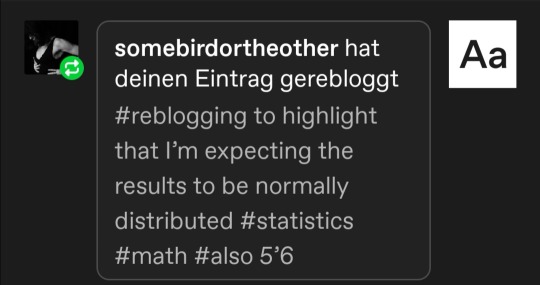
What does it say about us that I thought the exact same thing? 🙃😂
This ask refers to @lady-of-imladris and I participating in a poll about Tumblr User Height.
To answer the question - what this says about us is that we don't only like math, but that we are math.
I should do a little Statistics lesson for everyone, shouldn't I?
*crowd boos, screams 'no', shakes heads vehemently*
Ah, but of course, I'll do a little Statistics lesson dedicated to Normal Distribution.
The Normal Distribution (or "bell curve"), also known as the Gaussian distribution, is named after the mathematician Carl Friedrich Gauss, who made significant contributions to the field. It is a statistical distribution that appears frequently in nature and various disciplines.
It is characterized by two parameters: the mean (µ), which indicates the average or central value, and the standard deviation (σ), which measures the spread or dispersion. In a normally distributed dataset, about 68% of the data falls within one standard deviation from the mean, 95% within two standard deviations, and 99.7% within three standard deviations.
The curve is symmetrical around the mean, and its shape resembles that of a bell. It has a peak at the mean value, and it tails off towards the extremes, indicating that extreme values are less likely to occur compared to values near the mean.
The normal distribution is significant in statistics and the natural sciences for several reasons. Firstly, it provides a useful approximation for a wide range of phenomena. Secondly, due to the Central Limit Theorem, the means of samples from any distribution, given a sufficiently large sample size, will approximate a normal distribution. This makes it a powerful tool for inferential statistics.
Now, as to why human heights are normally distributed: it's largely a consequence of how multiple independent genetic and environmental factors influence height. Essentially, height is influenced by a multitude of factors—genes from both parents, diet, exercise, overall health, etc. When you have a lot of independent variables contributing to a single outcome, the Central Limit Theorem kicks in, and the outcome tends to follow a normal distribution.
So, in the case of human heights, the multitude of independent factors—each with their own distributions—coalesce to form a composite that approximates a normal distribution. This phenomenon is not unique to height; it also applies to other traits and measurements in various domains, from biology to social sciences.
Some additional interesting facts about Gaussian Distribution:
Multimodal and Multivariate: The concept of a normal distribution extends into higher dimensions as well. For example, bivariate normal distributions describe two variables, and multivariate normal distributions can encompass even more.
Operations Research (my field!): The normal distribution is a cornerstone concept in the field of Operations Research as well, being pivotal in stochastic models and simulations. Its ubiquity and versatility make it a continually fascinating subject of study.
Limitations: It's important to note that not everything follows a normal distribution. For example, income, populations of cities, and many natural phenomena like earthquake magnitudes tend to follow a power-law distribution.
Benford's Law: In a somewhat counterintuitive fashion, the leading digits of data from naturally occurring phenomena often do not follow a normal distribution but instead tend to follow Benford's Law, which is logarithmic.
My personal favourite statistical test for normality is Kolmogorov-Smirnov test.
Anyway, thanks for reading! Come again for more math, dear friends!


16 notes
·
View notes
Text
The Cube of Frangible Histories
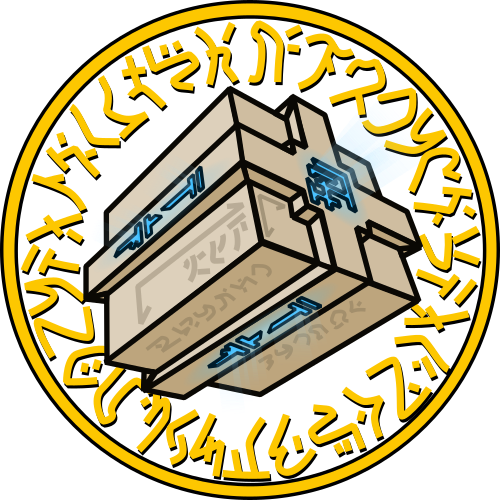
In certain conditions which are not typically found in nature--say, the presence of a rapidly spinning parachronic charge--particles not only need not have consistent histories, they may have histories which actively contradict one another. By using a sufficiently powerful telic discriminator, the Cube can induce and magnify such contradictions to alter the history of individual macroscopic objects. This can be used to modify, repair, or destroy objects to an almost infinite degree, although not in ways which outright contradict the local laws of reality.Altering the history of a person or object does not alter history for any other person or object; they will remember history as they experienced it before you used the cube. Persons on whom the cube is used remember only their new history. The operator of the cube can use it on themselves without issues. Operation of the cube requires touch contact, but the interface itself uses sophisticated mind-scanning technology to accurately interpret the intent of the operator, which it will attempt to fulfill to the best of its abilities. If the Cube cannot alter an object’s history as desired, its surface markings will flash once. It the Cube succeeds in carrying out the operator’s instructions, its surface markings will flash twice, and it will emit a low tone. DO NOT ATTEMPT TO ALTER OR DESTROY THE CUBE OF FRANGIBLE HISTORIES BY USING THE CUBE ON ITSELF.
The energy requirements of the cube scale according to the equation 4/3 * pi * k * m * s³, where s is the difference in time between the point of divergence for the new history of the object and its former history, and the present moment; m is the mass of the object in kg; and k is a constant reflecting the efficiency of the cube under various operating conditions. Under normal operating conditions, k = 3.515 * 10^-12, and a change to an objects history will take time to propagate to the present (as perceived by the operator); this time is equal to the cube root of s.
For example, let's say you wish to use the cube to alter a map so that when it was made, the creator included information that was omitted in the present timeline. The map has a mass of 5 g, or 0.005 kg. It was created ten days ago, which is 864,000 seconds. The energy needed to alter the map is 4/3 * pi * 3.515*10^-12 * 0.005 * 864,000^3, or ~11,000 joules, and it will take about a minute and a half for the change to become visible.
A skilled operator can reduce the time required for a change in an object's history to propagate to the present, at the cost of an increase in the base energy required. To reduce the time to the fourth root of s, multiply k by 10; to reduce the time to the fifth root of s, multiply k by 100; and so forth. Additionally, the following conditions alter the base energy required to use the cube:
Presence of a static parachronic charge (k is multiplied by pi for every unit charge)
Presence of a spinning parachronic charge (k is multiplied by pi and the angular velocity of the charge source in radians per second if the source is spinning in the opposite direction from the cube's natural orientation; k is *divided* by pi and the angular velocity of the charge source in radians per second if the source is spinning in the same direction from the cube's natural orientation. To find the cube's natural orientation, examine the symbols on the surface and apply the right-hand rule.)
Presence of a countertelic disruption field ("prophecy-supressor") (k is multiplied by 10 times the field intensity in Humes)
Outsized mass: above ~153 kg, k is multipled by one plus the natural logarithm of the mass minus log(153) (about 5). So for a 300kg object, k is multiplied by 1 + log(300) - log(153) or ~1.7.
The Cube is a metal object approximately 8.3 cm on a side, with a mass of ~6.4 kg, whose outer layer is composed of a metal alloy with a yield strength of about 1800 Mpa. The Cube can be powered by an electric current, a stream of charged plasma, a direct supply of both matter and antimatter, or by charged particle radiation. The Cube cannot operate above temperatures of 550 Kelvin or below 180 Kelvin. The Cube cannot operate in the ergosphere of a black hole, inside closed timelike curves, or when exposed to high concentrations of helium. If the functional interior of the Cube is critically damaged, or if the Cube is exposed to temperatures greater than about 2200 Kelvin, the Cube’s internal power source will explosively deconstruct, releasing 7.2 * 10^9 J of energy, mixed ionizing particle radiation including alpha, beta, gamma, and neutron radiation (30-40 Sv equivalent to those within 30 meters), and inert metal fragments.
Based on detailed studies, the conjectured results of attempting to alter or destroy the Cube using itself include:
Minor malfunction: operator is stuck in a time loop that is equal in duration t to the cube root of difference in seconds between the time the cube was used, and the time at which they attempted to retcon its destruction. This loop begins t seconds before they attempted to destroy the cube, and ends at the moment they originally attempted to destroy it. If they do not attempt to destroy it or if they are dead, the loop ends. (For longer loops, the loop can be treated as if it begins with the operator's birth.) Only the operator is aware of the loop.
Major malfunction: operator is stuck in a time loop that is equal in duration t to the cube root of difference in seconds between the time the cube was used, and the time at which they attempted to retcon its destruction. This loop begins t seconds before they attempted to destroy the cube, and ends at the moment they originally attempted to destroy it. Regardless of whether they attempt to destroy the Cube or not, the loop resets. The loop cannot be escaped by any means. Death, additional attempts to destroy the Cube (by any means), the use of time travel, travel to other realities or planes of existence, entering black holes or wormholes, and attempts to cause paradoxes reset the loop. From the perspective of the rest of the universe, the operator vanishes. Only the operator is aware of the loop.
Catastrophic malfunction: same as 2, but the operator and all living creatures with the capacity for memory within 25 meters of the cube when destruction was attempted are aware of the loop. This effect includes self-aware machines and excludes non-self-aware machines, regardless of their sophistication or design.
Paradox: the Cube and all matter within 25 meters is transformed to a black hole. Due to the small size of this black hole, it will evaporate rapidly; unless stabilized (or unless an extremely massive object is caught within this radius), the resulting black hole will almost instantaneously evaporate, releasing energy equivalent to the mass consumed as black-body radiation. At minimum, this will be equivalent to the mass of the Cube, i.e., an explosion roughly the size of the Krakatoa eruption.
Failsafe: the operator is removed from history; no one remembers their existence, and the timeline is altered to be consistent with their never having had existed. The exception to this is the Cube, which remains at the location it was in when the operator used it.
Failsafe malfunction: The operator and all matter that was within 25 meters of the Cube in the original timeline are erased from history. The exception to this is the Cube, which remains at the location it was in when the operator used it.
29 notes
·
View notes
Text
Psychology Today: Consciousness and Intrinsic Brain Information
Does consciousness arise exclusively from complex interactions in brain tissue (materialism)? Or does consciousness originate in some more fundamental level of reality (dualism)? Many nuanced philosophical versions of these positions have surfaced in recent years. The new science of consciousness remains consistent with established physical laws, while fully embracing the knowledge barriers and "hidden reality" imposed by modern physics.
Computer science contributes to this debate through developments in artificial intelligence (AI). A substantial blurring of distinctions between materialism and dualism may be in the works. One source of shifting viewpoints stems from a deeper appreciation of the role of information in both the physical and biological sciences. Information and consciousness appear to be close relatives, some even view them as marriage partners. Prominent scientists and philosophers may claim that “consciousness is just brain-wide information sharing.” But just what is this enigmatic entity “information,” a label often embraced with more enthusiasm than critical scrutiny?
Scientists naturally search for ways to identify, and hopefully even measure, some well-defined “intrinsic information content” of brains. One of today’s leading theories of consciousness was discussed briefly in my post of December 13, 2021, Consciousness and Integrated Information Theory (IIT), a controversial idea with plenty of supporters and detractors. One major issue for any information-based theory is that the meaning of “brain information” is generally subjective and context-dependent.
Information processing may involve multiple levels of organization, ranging from protein molecules, including the tiny microtubules, to cellular scales, to brain-wide cell assemblies to global fields of synaptic action. These nested structures can form and dissolve in fractions of seconds, changing their organizations and mutual alliances at the speed of thought. Brain structures are often loosely labeled as “neural networks,” but their relationships to AI networks might be anything from genuine physical analogs to loose metaphorical similarities. My purpose in this new series of posts is to examine possible relations between information and consciousness, starting at the most basic level so that the discussion is easily available to any interested reader.
Let’s first visit the “binary world” of information. Binary numbers are physically convenient. Bones placed on the ground, beads sliding on sticks, and punched holes in paper tapes have long been used to store and manipulate binary information. Punch cards were the standard means of inputting binary data to early computers. When punched properly, each card location either has a hole or no hole. A famous example of binary misuse involved the “hanging chads” of the 2000 U.S. presidential election. The world of binary information has taken on deep scientific significance—in the second law of thermodynamics, quantum mechanics, biological systems, and more.
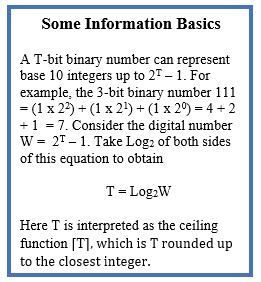
Some Information Basics
Paul L. Nunez
Imagine sand buckets placed in a straight line on a beach. Empty buckets are designated 0 and sand-filled buckets are designated 1; fractional fills are not allowed. I adopt the symbol T (after computer scientist Alan Turing) to indicate the number of buckets in the line. As shown in my first figure, a T-bit binary number can represent base-10 integers up to the maximum number W = 2T – 1. Solving this equation for T yields the minimum number of bits (buckets or binary digits) needed to store the number W: T = Log2W. The right side is read, “the base 2 logarithm of W”. This equation has no fixed scientific meaning; it is simply the rule for transforming any base-10 number W into a binary number T, analogous to a simple mathematical rule like A x B = B x A. The binary transformation rule adopts the ceiling function of computer science, the provision that non-integer values of T are to be rounded up to the nearest integer. Thus, for example, ceiling function (6.2) = 7 bits or buckets; no partly filled buckets or hanging chads are allowed.
State Information
A system’s state is the collection of features that describe its condition, at a fixed time or, more likely, over a specified time average. This simple definition masks an extensive assortment of subtle issues that must be faced head-on in the quest to better understand consciousness. State information may be defined simply by the number of possible states of a system, let’s say water, which can be found in the states of solid, liquid, or gas. Economies, forests, and ant colonies can exist in different states. Brains can occupy many mental states—awake, dreaming, Alzheimer’s disease, planning a bank robbery, or thinking great thoughts. Neuroscience seeks relationships between mental states and measurable physical states. Such relationships are labeled the neural correlates of consciousness.
Let’s begin our discussion of states with simple die systems. If a single cubical die is placed or tossed on a surface, the six possible states of the system are 1 through 6. A polyhedron die is a three-dimensional object with W flat surfaces. If, for example, W = 128, each system state can be unequivocally labeled by a single positive integer in the range 1 through 128. This state description is independent of the causes or probabilities of occurrence of each state, which might be the result of a simple die toss, deliberate placement by an intelligent being, or some hidden process. We only require that the system be found in one of the 128 discrete states, independent of the cause or means of observation. The size of state information is defined simply as W, the number of distinct states that the system can be in. To be more precise, we may call W the size of the die's macro-state to distinguish it from the micro-states, which are determined by the locations and velocities of the elementary particles forming the die. State size can also be expressed by T, the number of bits corresponding to W.
Shannon Entropy
State information is often confused with Shannon information (or entropy) developed in modern communication theory. According to Shannon information, a message consists of a sequence of M symbols selected from an alphabet consisting of N symbols. For example, the 7-bit computer code ASCII can contain up to N = 128 symbols. Consider the message, “The Bird is cruel!”, which probably means nothing much to the reader unless he or she has read science fiction by Robert Heinlein. The message consists of M = 18 symbols, including letters, spaces, and an exclamation point. In the common practice of sending messages, meaning is supplied by both the message content and prior knowledge of the receiver. In contrast, the central goal of communication theory is to provide quantitative measures of the information content of messages, independent of meaning.
A message’s Shannon information is defined in terms of the probability of occurrence of each symbol produced by the sending system (whether human or machine). For example, the letter E is more likely to occur than other letters in English text. The information transmitted by each symbol involves a degree of receiver surprise; the letter Z conveys more information than the letter E and so forth. Shannon information is, by definition, additive. Each additional symbol received adds more information, but the additional information varies in size, depending on symbol probabilities in the chosen alphabet. Shannon entropy H is the average number of bits of information per transmitted symbol. If an entire alphabet were to contain only a single symbol, Hwould be zero. On the other hand, if all symbols were to have an equal probability of occurrence, Shannon entropy takes on its maximum value: H = Log2M. More generally, the Shannon entropy H of any collection of symbols, including but not limited to alphabets, lies in the range between zero and Log2M, depending on the probability distribution of the alphabet. H may or may not have any relationship to the intrinsic properties of the sender.
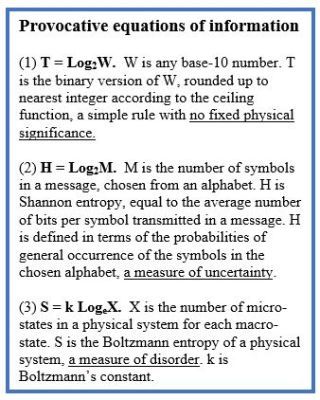
Provocative Equations of Information
Paul L. Nunez
Three major kinds of information are defined in figure 2: T (Turing buckets), H (Shannon entropy), and S (Boltzmann entropy). The three equations are nearly identical but express very different physical processes. The discovery of entropy in the mid 1800s was followed by the development of statistical mechanics in the late 1800s and Shannon’s communication theory in 1949. Many seem to have fallen for the fallacy that T, H, and S are the same creature because they satisfy (essentially) the same equation. In this regard, note that mechanical and electrical systems are often described by identical differential equations, providing the basis for analog computers.
Widespread confusion about information and entropy also originates from their inherently abstract nature, mixed interpretations of the symbols H and S, and the births and on-going maturation of many new informational siblings. For example, Boltzmann's sharp distinction between the macro and micro-states in classical statistical mechanics is not fully adequate to describe complex systems.
Brains other complex systems operate at multiple intermediate scales, leading to multi-scale entropy measures. The confusion continues to this day, especially with the advent of AI, quantum computing with quantum bits (qubits), quantum superposition of states, black hole entropy, cellular information processing, and much more. In future posts, I will discuss other kinds of information that appear to be related to consciousness.
Several efforts to find better-defined measures of intrinsic brain information have tentatively adopted Shannon entropy by interpreting the symbols of the Shannon message (M) as measured brain states (W), adopting Shannon entropy (H) as an approximation of the brain’s intrinsic information. One obvious problem with this approach is that the contents of a message may tell us almost nothing about the internal states of the sender. If the sender is a very simple system, like our 128-face die, its message may provide much of the die’s intrinsic macro-scale information. However, in brains as well as other complex systems, the relationships between the system messages (often obtained from experimental data) and the intrinsic information of the system is tenuous at best. I will look into these issues in more depth in my next post.
2 notes
·
View notes
Text
What is Sacred Geometry and how can you benefit from it?

BY TINY DEVOTIONS
The term ‘Geometry’ has its origin from two Greek words: Geos, which mean Earth and Metron, which means ‘to measure.’ The two words together literally mean ‘measuring the earth’ or ‘earthly measurements.’ Measuring the earth was an art that was traditionally restricted to the priesthood.
Sacred geometry has been around across the ages, beginning with the Minoans, the Egyptians, Sumerians, Hindus, Chinese, Phoenicians, and the Greeks who offered it to the public.
Sacred geometry refers to the various shapes and forms that were traditionally used in architecture, art, and meditation through the centuries. They are the same forms and shapes that are found in natural organisms.
To many people, sacred geometry seems to be esoteric but it is important to understand the same as they could help us view our world, which could be useful in our own life.
In ancient cultures, there was the recognition that various patterns or geometric shapes appear repeatedly throughout nature such as the spiral shell of snails and the hexagonal honeycombs. These common shapes and patterns that can be seen in nature are referred to as sacred geometry. Sacred geometry may be broken down further in mathematical formulas and symbols that form the building blocks of everything in the universe.
This ancient theory is supported by modern science because the molecular shapes form the basis of life, the same shapes that are identified by ancient cultures.
It is believed that the construction of sacred structures, such as mosques, temples, monuments, megaliths, and churches; sacred spaces such as tabernacles or altars; historical buildings, such as the pyramids of Egypt, the Parthenon in Greece, and the temples found throughout South and Central America; meeting places; and the creation of religious arts and iconography. Sacred geometry in arts may be ephemeral, such as sand paintings, medicine wheels, and visualization.

Sacred geometry is a worldview of pattern recognition. It is a complex system of religious structures and symbols that involve time, space, and form. Following this view, the basic patterns of existence are sacred. By studying the nature of the forms, patterns, and relationships and their connections, it will be easier to gain an insight into the history and mysterious laws of the Universe.
Sacred Geometry’s significant shapes
Sphere
It is a container that has the ability to hold all forms. Sphere represents inclusion, oneness, and integrity because all measurements are equal in a sphere. The spherical shape can be seen in planets, cells, seeds, and atoms.
Circle
It is a two-dimensional representation of the sphere. It shows the total completeness and unity of the universe. The ratio of its circumference compared to its diameter is the Pi, an infinite number that never ends.
Point
It is the center of both a sphere and a circle. The point is the beginning and the end of all measurements, hence its association with the beginning and the end of all creations.
Spirals
All types of spirals – flat, right-handed, left-handed, 3-D, equiangular, or logarithmic – show expansion and growth, which makes them symbolize infinity.
Toroids
A torus is similar to an inner tube, with the round sides perfectly circular. The torus is a primary shape in sacred geometry, such as the seven primary muscles in the heart having a toroid shape.
The Vesica Piscis
The words are Latin for a bladder of fish. It is actually the intersection of two circles having the same size as their centers touching each other. It represents common ground between people. It is the symbol of Christ in the Christian religion.
Platonic solids
They are 3-dimensional shapes with each one made of equal-sized faces. The platonic solids are:
Tetrahedron – 4 faces of pyramid shapes
Hexahedron – 6 faces such as a cube
Octahedron – 8 faces
Dodecahedron – 12 faces
Icosahedron – 20 faces
Metatron’s Cube
The Metatron’s cube contains all the Platonic solids, making it called the building blocks of creation. Metatron in Judaism is the angel who is guarding God’s throne.
Flower of Life

It is represented by several evenly-spaced circles that overlap each other, forming a flower-like pattern. The Flower of Life contains all the Platonic solids and Metatron’s Cube.
The Golden Ratio
It is a mathematical ratio occurring when two items having the same ratio when compared to each other as the ratio of their sum compared to the larger of the two items.
Sacred Geometry Jewelry
Sacred Geometry has been used by anthropologists, archeologists, and geometricians in incorporating the religious, spiritual, and philosophical beliefs that have sprung up from geometry in various cultures over the centuries. The various shapes of sacred geometry can be found everywhere in nature as they reveal to mankind the concept of oneness through geometry.
The various sacred geometry shapes have been incorporated in jewelry designs in order to facilitate the balance, healing, and self-discovery while at the same time inspiring the wearer as he or she travels towards the totality and unity of the whole self.
Tiny Devotions

We are a sisterhood devoted to empowering the bold and courageous women of the community. The various types of jewelry that we create are meant to activate energy and knowledge in the mind as a way of achieving spiritual clarity. By exploring the building blocks of the universe through the different jewelry pieces, one can find the secret source of life.
http://www.bohodaily.com/
8 notes
·
View notes